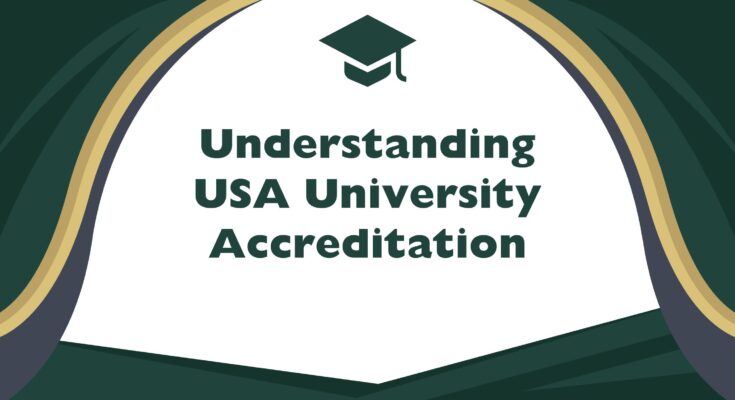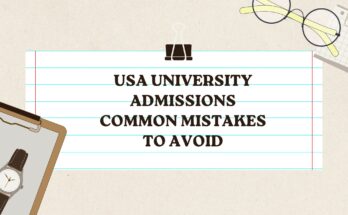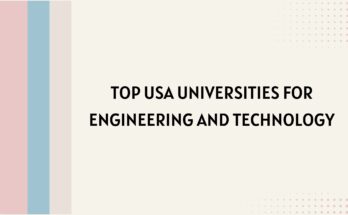Choosing a university in the United States can be a daunting task, especially with the vast number of institutions available. One crucial factor that can help narrow down your choices and ensure you receive a quality education is understanding university accreditation. Accreditation is a process by which institutions are evaluated and recognized for meeting certain standards of quality and integrity. In this blog post, we will delve into the details of university accreditation in the USA, its importance, types, and how to verify if a university is accredited.
Understanding USA University Accreditation
What is University Accreditation?
Accreditation is a voluntary process that universities undergo to demonstrate that they meet established standards of excellence in education, administration, and services. This process is conducted by private accrediting agencies that are recognized by the U.S. Department of Education (DOE) and the Council for Higher Education Accreditation (CHEA). The main purpose of accreditation is to ensure that students receive a quality education that is recognized and respected by employers and other educational institutions.
The Importance of Accreditation
Accreditation serves several key purposes:
- Quality Assurance: It guarantees that an institution meets certain standards of quality, ensuring that students receive a valuable education.
- Transferability of Credits: Credits earned at an accredited institution are more likely to be recognized by other universities, which is crucial for students who may transfer or pursue further education.
- Eligibility for Federal Financial Aid: Only students attending accredited institutions are eligible for federal financial aid programs, including grants, loans, and work-study opportunities.
- Employment Opportunities: Employers often prefer candidates who have graduated from accredited institutions, as it assures them of the quality of education received.
- Licensure and Certification: Many professional licenses and certifications require candidates to have graduated from an accredited program.
Types of Accreditation
In the United States, there are two main types of accreditation: institutional and specialized (or programmatic).
- Institutional Accreditation
- Regional Accreditation: This is the most prestigious type of accreditation and is granted to an entire institution. It is conducted by one of seven regional accrediting bodies in the United States. Regional accreditation is generally considered more rigorous and prestigious than national accreditation. Institutions with regional accreditation often have higher academic standards and are more widely recognized.
- National Accreditation: This type of accreditation is typically granted to institutions that offer vocational, technical, or career-oriented programs. National accrediting agencies often accredit institutions that focus on a specific field of study or type of education, such as religious schools or distance education providers.
- Specialized (or Programmatic) Accreditation: This is granted to specific programs, departments, or schools within a university. Specialized accreditation ensures that a particular program meets the standards set by professional organizations. For example, the American Bar Association accredits law schools, while the Accreditation Board for Engineering and Technology accredits engineering programs.
How Accreditation Works
The accreditation process involves several steps:
- Self-Study: The institution conducts a thorough self-evaluation to assess its programs, faculty, resources, and services. This self-study report is then submitted to the accrediting agency.
- Peer Review: A team of peer reviewers, typically composed of faculty and administrators from other accredited institutions, visits the campus to evaluate the institution’s compliance with the accrediting agency’s standards.
- Decision: Based on the self-study report and the peer review team’s findings, the accrediting agency makes a decision regarding the institution’s accreditation status. This decision can result in full accreditation, conditional accreditation, or denial of accreditation.
- Continuous Improvement: Accredited institutions must undergo periodic reviews to maintain their accreditation status. This ensures ongoing compliance with standards and continuous improvement.
Recognized Accrediting Agencies
The U.S. Department of Education and the Council for Higher Education Accreditation (CHEA) recognize a variety of accrediting agencies. Some of the major regional accrediting bodies include:
- Middle States Commission on Higher Education (MSCHE)
- New England Commission of Higher Education (NECHE)
- Higher Learning Commission (HLC)
- Southern Association of Colleges and Schools Commission on Colleges (SACSCOC)
- Western Association of Schools and Colleges (WASC)
- Northwest Commission on Colleges and Universities (NWCCU)
Additionally, there are numerous national and specialized accrediting agencies that focus on specific types of institutions and programs.
How to Verify Accreditation
Before enrolling in a university, it’s crucial to verify its accreditation status. Here are some steps to do so:
- Check the Institution’s Website: Most accredited universities prominently display their accreditation status on their website. Look for information about their accrediting bodies.
- Visit the Accrediting Agency’s Website: Accrediting agencies usually have a searchable database of accredited institutions on their websites. Verify that the university is listed.
- Use the U.S. Department of Education’s Database: The DOE maintains a comprehensive database of accredited institutions and programs, which can be accessed online.
- Check the Council for Higher Education Accreditation (CHEA) Website: CHEA also provides a searchable database of accredited institutions and recognized accrediting agencies.
Red Flags to Watch For
When researching universities, be aware of certain red flags that may indicate a lack of proper accreditation or questionable practices:
- Lack of Information: If a university does not provide clear information about its accreditation status, it may be a sign of a problem.
- Accrediting Agencies Not Recognized by DOE or CHEA: Some institutions may claim accreditation from agencies that are not recognized by the U.S. Department of Education or CHEA. Ensure the accrediting agency is legitimate and recognized.
- Unusually Low Tuition Fees: While affordable education is important, extremely low tuition fees can be a sign of a diploma mill or substandard education.
- High-Pressure Enrollment Tactics: Reputable institutions do not use aggressive sales tactics to enroll students. Be wary of universities that pressure you to enroll quickly.
Conclusion
Understanding university accreditation in the USA is essential for making informed decisions about your education. Accreditation ensures that you receive a quality education, have access to financial aid, and enjoy better career prospects. By knowing the types of accreditation, the accreditation process, and how to verify a university’s accreditation status, you can confidently choose an institution that meets your educational and professional goals. Remember, investing time in researching accreditation now can save you from potential headaches and disappointments in the future.



